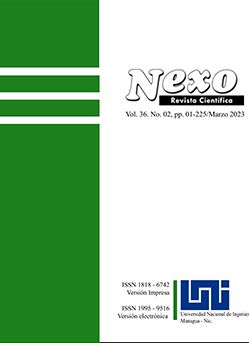Obtaining a coffee-flavored dairy drink using soy milk and whey
DOI:
https://doi.org/10.5377/nexo.v36i02.15997Keywords:
Dairy drink, cow's milk, soy milk, wheyAbstract
A dairy drink was obtained by mixing the raw materials whey, cow's milk and soy milk. The products to be used in the formulation of the beverages were characterized physically-chemically. A factorial design was carried out, where the levels of starch and whey were established. For this, the sugar concentration was fixed in the formulation of each of the experimental runs and the rest was completed with the whole cow's milk and soy milk components mixed in a 7/3 ratio. The best evaluated formulation was developed on a pilot scale and characterized. In the case of 1.2% starch, regardless of the whey content in the formulations, better results were always obtained. It was appreciated that the sensory quality of the product is conditioned by both the viscosity and the milky taste. The best evaluated formulation by the tasters was the one containing 1.2% starch and 30% whey. The sensory characterization of the beverage showed excellent quality, due to the perception of a correct combination of coffee flavor, soy flavor, and milk flavor. It presented a total solids content of 17.8% and an acidity of 0.07%.
Downloads
674
Downloads
Published
How to Cite
Issue
Section
License
Copyright (c) 2023 Universidad Nacional de Ingeniería

This work is licensed under a Creative Commons Attribution 4.0 International License.
The authors who publish in Nexo Scientific Journal agree to the following terms:
- Authors retain the copyright and grant the journal the right of the first publication under the license Creative Commons Attribution License, which allows others to share the work with a recognition of the authorship of the work and the initial publication in Nexo Scientific Journal.
- Authors may separately establish additional agreements for the non-exclusive distribution of the version of the work published in the journal (for example, in an institutional repository or a book), with the recognition of the initial publication in Nexo Scientific Journal.
- Authors are allowed and encouraged to disseminate their works electronically (for example, in institutional repositories or in their own website) before and during the submission process, as it can lead to productive exchanges, as well as earlier and greater citation of published works.










